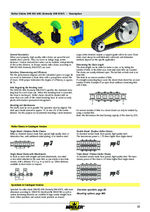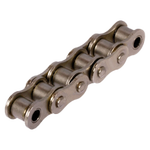Search & Find
The right product
Categories
Chains
When used properly, high quality roller chains are powerful and reliable drive systems. They can serve to bridge large centre distances. Various transmission ratios can be realized, independently of the centre distance. In Europe mainly roller chains according to DIN ISO 606 (ex DIN 8187) are used.
Note Regarding the Breaking Load
The DIN ISO 606 (ex DIN 8187) specifies the minimum breaking
load for each chain size. When this breaking load is exceeded, the
chain is destroyed. Roller chains should be loaded with no more
than one sixth of the stated breaking load, to avoid an early plastic
deformation (permanent elongation).
Mounting and Maintenance
The shafts must be set in parallel. The sprockets must be aligned. The slack span should amount to approx 1% to max 2% of the centre distance. For this purpose we recommend mounting a chain tensioner. Large centre distances require a support (guide rail) to be used. Chain drives must always be well lubricated. Lubricants and lubrication
methods depend on the specific application.
Determining the Chain Length
The chain length can be stated in meter or mm, or by stating the number of links. In the latter case, inner and outer links are counted. The chains are usually delivered open. The last link on both ends is an inner link. This leads to an uneven number of links. If a straight connecting ling is used, the closed chain strand has an even number of links.
Downloads
Zoek & vind
The right product

